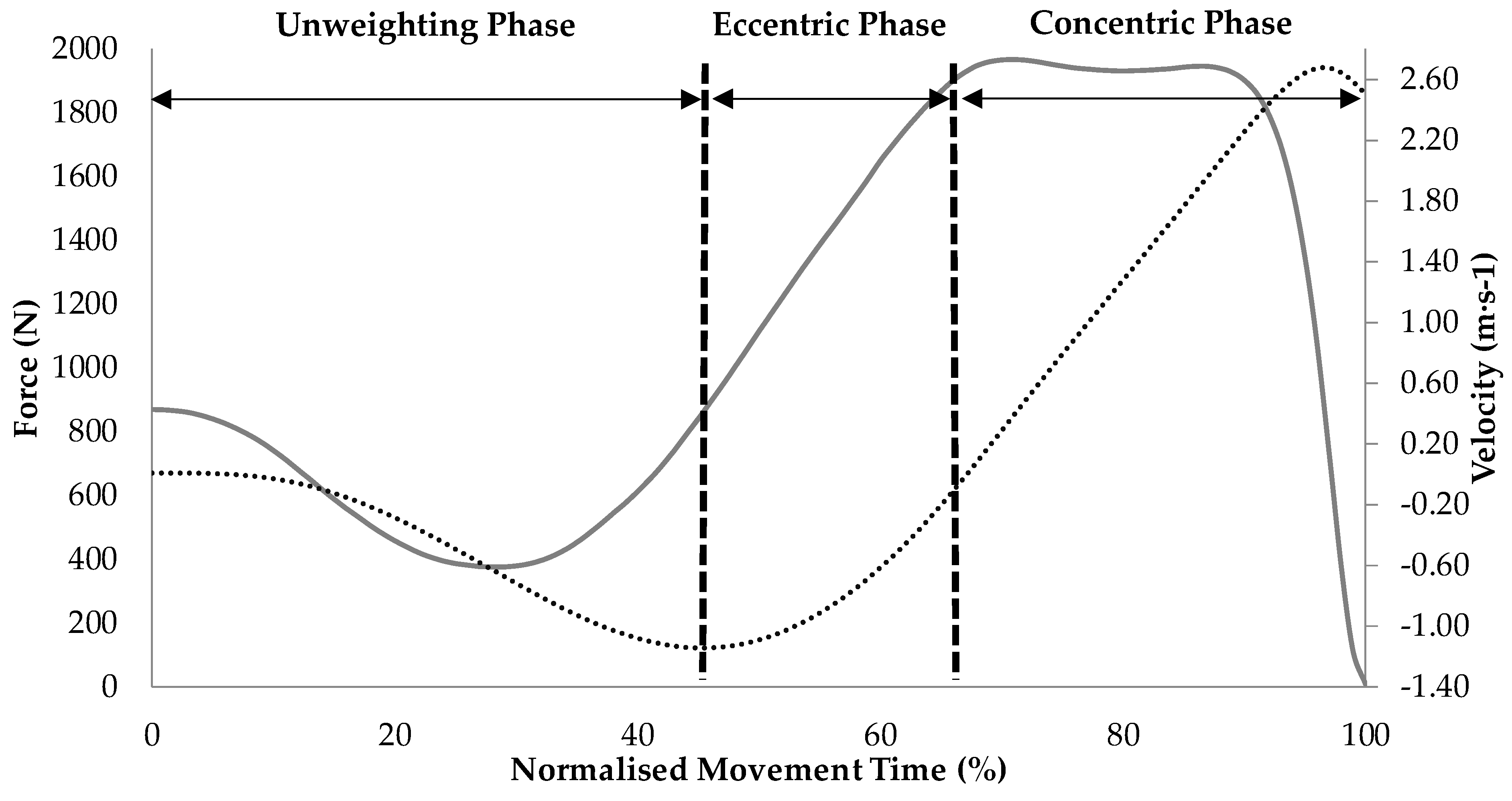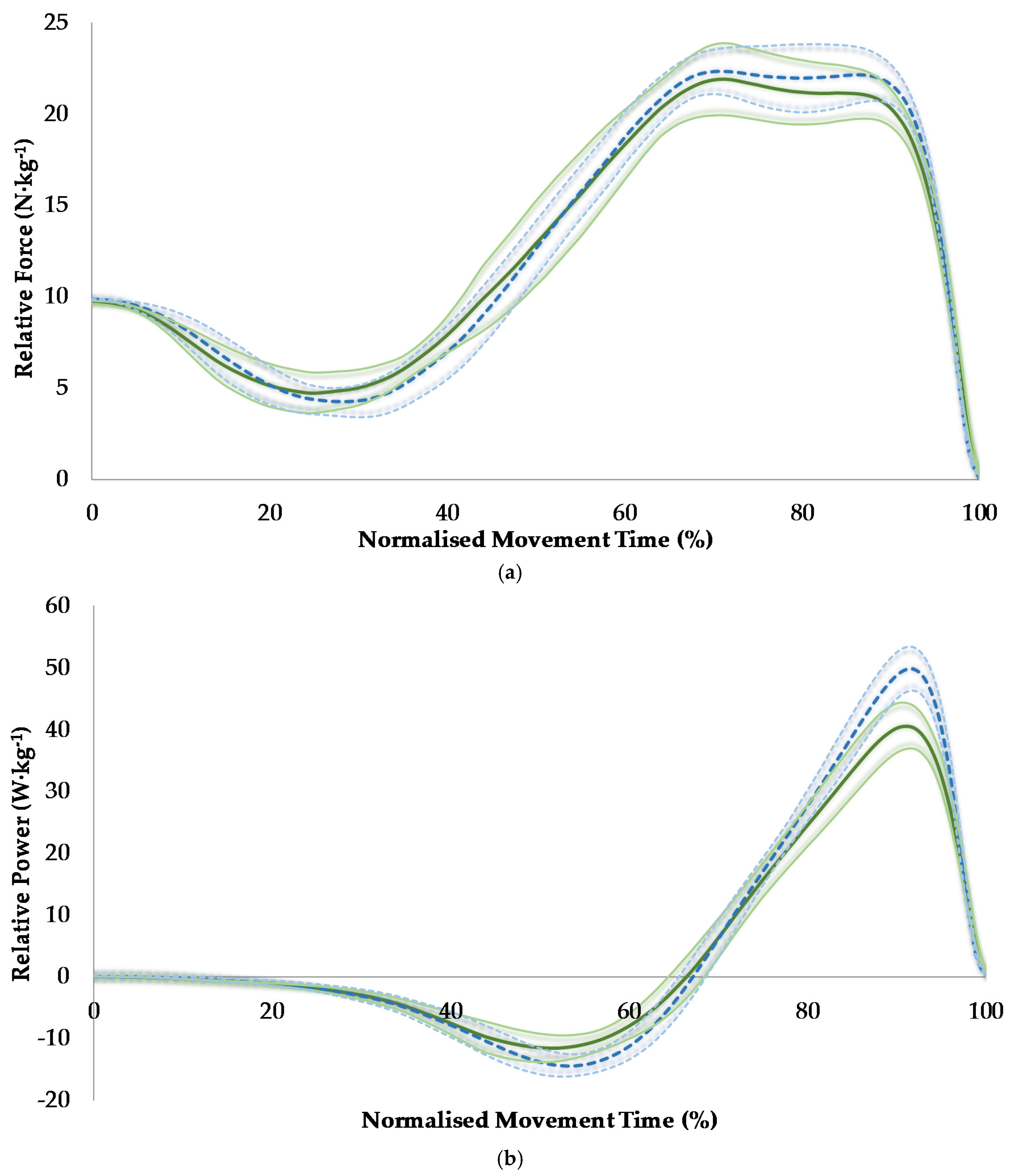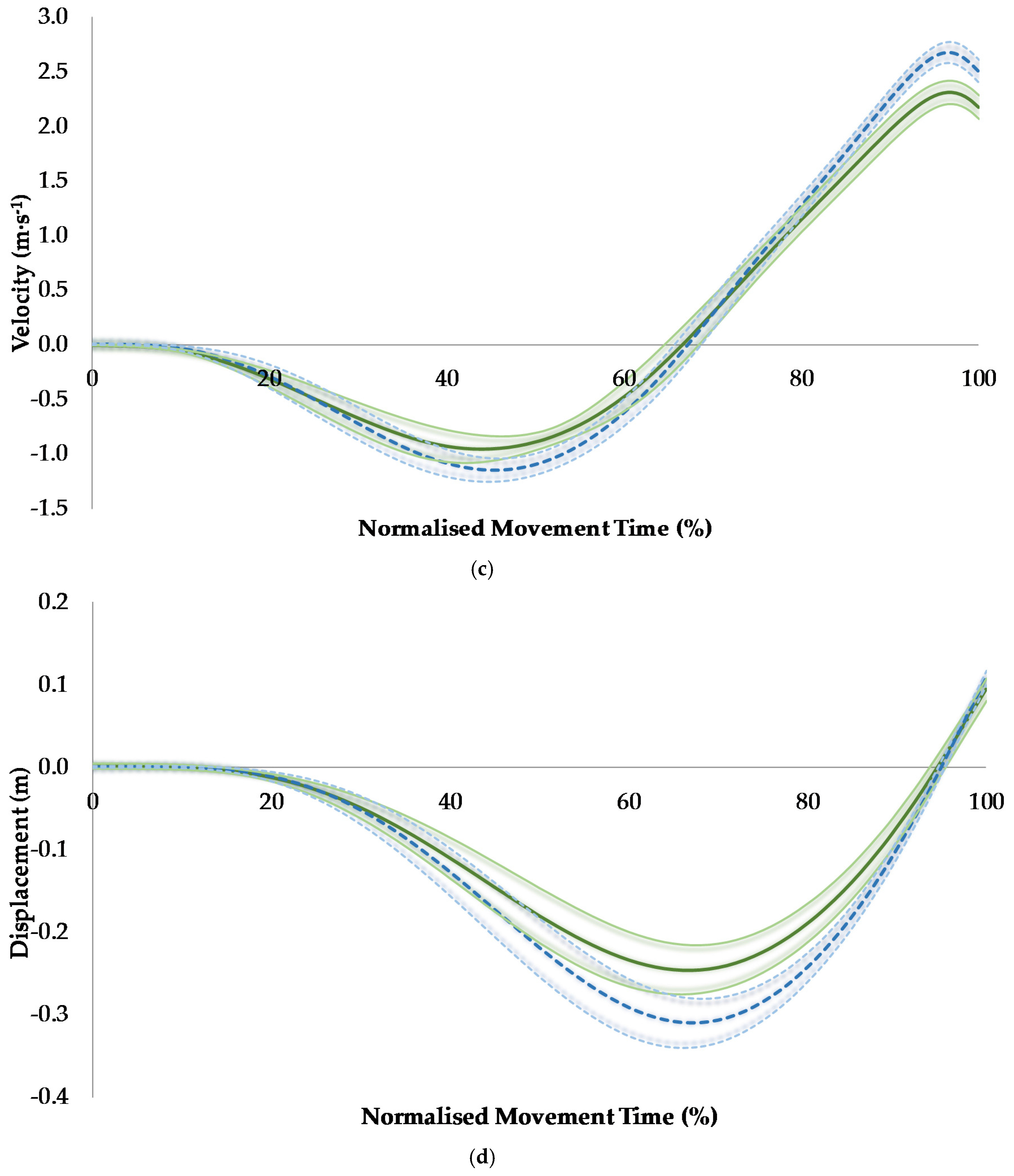Sex Differences in Countermovement Jump Phase Characteristics
Abstract
:1. Introduction
2. Materials and Methods
2.1. Subjects
2.2. Procedures
2.3. Data Collection
2.4. Data Analysis
2.5. Statistical Analysis
3. Results
4. Discussion
5. Conclusions
Author Contributions
Conflicts of Interest
References
- Cormie, P.; McBride, J.M.; McCaulley, G.O. Power-Time, Force-Time, and Velocity-Time Curve Analysis of the Countermovement Jump: Impact of Training. J. Strength Cond. Res. 2009, 23, 177–186. [Google Scholar] [CrossRef] [PubMed]
- Cormie, P.; McGuigan, M.R.; Newton, R.U. Adaptations in Athletic Performance after Ballistic Power versus Strength Training. Med. Sci. Sports Exerc. 2010, 42, 1582–1598. [Google Scholar] [CrossRef] [PubMed]
- Cormie, P.; McGuigan, M.R.; Newton, R.U. Influence of Strength on Magnitude and Mechanisms of Adaptation to Power Training. Med. Sci. Sports Exerc. 2010, 42, 1566–1581. [Google Scholar] [CrossRef] [PubMed]
- McMahon, J.J.; Comfort, P.; Pearson, S. Lower limb stiffness: effect on performance and training considerations. Strength Cond. J. 2012, 34, 94–101. [Google Scholar] [CrossRef]
- Mundy, P.D.; Smith, N.A.; Lauder, M.A.; Lake, J.P. The effects of barbell load on countermovement vertical jump power and net impulse. J. Sports Sci. 2016. [Google Scholar] [CrossRef]
- Gathercole, R.; Sporer, B.; Stellingwerff, T.; Sleivert, G. Alternative Countermovement-Jump Analysis to Quantify Acute Neuromuscular Fatigue. Int. J. Sports Physiol. Perform. 2015, 10, 84–92. [Google Scholar] [CrossRef] [PubMed]
- Gathercole, R.J.; Sporer, B.C.; Stellingwerff, T.; Sleivert, G.G. Comparison of the Capacity of Different Jump and Sprint Field Tests to Detect Neuromuscular Fatigue. J. Strength Cond. Res. 2015, 29, 2522–2531. [Google Scholar] [CrossRef] [PubMed]
- Gathercole, R.J.; Stellingwerff, T.; Sporer, B.C. Effect of Acute Fatigue and Training Adaptation on Countermovement Jump Performance in Elite Snowboard Cross Athletes. J. Strength Cond. Res. 2015, 29, 37–46. [Google Scholar] [CrossRef] [PubMed]
- Coelho E Silva, M.J.; Figueiredo, A.J.; Moreira Carvalho, H.; Malina, R.M. Functional capacities and sport-specific skills of 14- to 15-year-old male basketball players: Size and maturity effects. Eur. J. Sport. Sci. 2008, 8, 277–285. [Google Scholar] [CrossRef]
- Coelho E Silva, M.J.; Moreira Carvalho, H.; Gonçalves, C.E.; Figueiredo, A.J.; Elferink-Gemser, M.T.; Philippaerts, R.M.; Malina, R.M. Growth, maturation, functional capacities and sport-specific skills in 12–13 year-old- basketball players. J. Sports Med. Phys. Fit. 2010, 50, 174–181. [Google Scholar]
- Ebben, W.; Flanagan, E.; Jensen, R. Gender similarities in rate of force development and time to takeoff during the countermovement jump. J. Exerc. Physiol. Online 2007, 10, 10–17. [Google Scholar]
- Laffaye, G.; Wagner, P.P.; Tombleson, T.I.L. Countermovement Jump Height: Gender and Sport-Specific Differences in the Force-Time Variables. J. Strength Cond. Res. 2014, 28, 1096–1105. [Google Scholar] [CrossRef] [PubMed]
- Rice, P.E.; Goodman, C.L.; Capps, C.R.; Triplett, N.T.; Erickson, T.M.; McBride, J.M. Force- and power-time curve comparison during jumping between strength-matched male and female basketball players. Eur. J. Sport Sci. 2016. [Google Scholar] [CrossRef] [PubMed]
- Alegre, L.M.; Lara, A.J.; Elvira, J.L.L.; Aguado, X. Muscle morphology and jump performance: Gender and intermuscular variability. J. Sport Med. Phys. Fit. 2009, 49, 320–326. [Google Scholar]
- Moir, G.L. Three Different Methods of Calculating Vertical Jump Height from Force Platform Data in Men and Women. Meas. Phys. Educ. Exerc. 2008, 12, 207–218. [Google Scholar] [CrossRef]
- Rubio-Arias, J.Á.; Ramos-Campo, D.J.; Peña Amaro, J.; Esteban, P.; Mendizábal, S.; Jiménez, J.F. Gender variability in electromyographic activity, in vivo behaviour of the human gastrocnemius and mechanical capacity during the take-off phase of a countermovement jump. Clin. Physiol. Funct. Imaging 2016. [Google Scholar] [CrossRef] [PubMed]
- Riggs, M.P.; Sheppard, J.M. The relative importance of strength and power qualities to vertical jump height of elite beach volleyball players during the counter-movement and squat jump. J. Hum. Mov. Sport Exerc. 2009, 4, 221–236. [Google Scholar] [CrossRef]
- McMahon, J.J.; Murphy, S.; Rej, S.J.E.; Comfort, P. Countermovement Jump Phase Characteristics of Senior and Academy Rugby League Players. Int. J. Sport Physiol. Perform. 2016. [Google Scholar] [CrossRef] [PubMed]
- Kirby, T.J.; McBride, J.M.; Haines, T.L.; Dayne, A.M. Relative net vertical impulse determines jumping performance. J. Appl. Biomech. 2011, 27, 207–214. [Google Scholar] [CrossRef] [PubMed]
- Walsh, M.S.; Böhm, H.; Butterfield, M.M.; Santhosam, J. Gender bias in the effects of arms and countermovement on jumping performance. J. Strength Cond. Res. 2007, 21, 362–366. [Google Scholar] [CrossRef] [PubMed]
- Owen, N.J.; Watkins, J.; Kilduff, L.P.; Bevan, H.R.; Bennett, M.A. Development of a Criterion Method to Determine Peak Mechanical Power Output in a Countermovement Jump. J. Strength Cond. Res. 2014, 28, 1552–1558. [Google Scholar] [CrossRef] [PubMed]
- McMahon, T.A.; Cheng, G.C. The mechanics of running: How does stiffness couple with speed? J. Biomech. 1990, 23, 65–78. [Google Scholar] [CrossRef]
- Ebben, W.P.; Petushek, E.J. Using the Reactive Strength Index Modified to Evaluate Plyometric Performance. J. Strength Cond. Res. 2010, 24, 1983–1987. [Google Scholar] [CrossRef] [PubMed]
- Cormie, P.; McBride, J.M.; McCaulley, G.O. Power-time, force-time, and velocity-time curve analysis during the jump squat: Impact of load. J. Appl. Biomech. 2008, 24, 112–120. [Google Scholar] [CrossRef] [PubMed]
- Fleiss, J.L. Reliability of Measurement. In The Design and Analysis of Clinical Experiments; John Wiley & Sons, Inc.: New York, NY, USA, 1999; pp. 1–32. [Google Scholar]
- Cormack, S.J.; Newton, R.U.; McGuigan, M.R.; Doyle, T.L.A. Reliability of Measures Obtained during Single and Repeated Countermovement Jumps. Int. J. Sport Physiol. Perform. 2008, 3, 131–144. [Google Scholar] [CrossRef]
- Rhea, M.R. Determining the magnitude of treatment effects in strength training research through the use of the effect size. J. Strength Cond. Res. 2004, 18, 918–920. [Google Scholar] [CrossRef] [PubMed]
- Suchomel, T.J.; Sole, C.J. Force-Time Curve Comparison between Weightlifting Derivatives. Int. J. Sport Physiol. Perform. 2016. [Google Scholar] [CrossRef] [PubMed]
- McMahon, J.J.; Comfort, P.; Pearson, S. Lower limb stiffness: Considerations for female athletes. Strength Cond. J. 2012, 34, 70–73. [Google Scholar] [CrossRef]
- McMahon, J.J.; Ripley, N.J.; Rej, S.J.E. Effect of modulating eccentric leg stiffness on concentric force-velocity characteristics demonstrated in the countermovement jump. J. Sport Sci. 2016, 34, s19. [Google Scholar]
- Arampatzis, A.; Bruggemann, G.P.; Klapsing, G.M. Leg stiffness and mechanical energetic processes during jumping on a sprung surface. Med. Sci. Sports Exerc. 2001, 33, 923–931. [Google Scholar] [CrossRef] [PubMed]
- Arampatzis, A.; Schade, F.; Walsh, M.; Bruggemann, G.P. Influence of leg stiffness and its effect on myodynamic jumping performance. J. Electromyogr. Kinesiol. 2001, 11, 355–364. [Google Scholar] [CrossRef]
- Nuzzo, J.L.; McBride, J.M.; Cormie, P.; McCaulley, G.O. Relationship between Countermovement Jump Performance and Multijoint Isometric and Dynamic Tests of Strength. J. Strength Cond. Res. 2008, 22, 699–707. [Google Scholar] [CrossRef] [PubMed]
- Thomas, C.; Jones, P.A.; Rothwell, J.; Chiang, C.Y.; Comfort, P. An Investigation into the Relationship between Maximum Isometric Strength and Vertical Jump Performance. J. Strength Cond. Res. 2015, 29, 2176–2185. [Google Scholar] [CrossRef] [PubMed]
- Cormie, P.; McGuigan, M.R.; Newton, R.U. Changes in the eccentric phase contribute to improved stretch-shorten cycle performance after training. Med. Sci. Sports Exerc. 2010, 42, 1731–1744. [Google Scholar] [CrossRef] [PubMed]
- Aagaard, P.; Andersen, J.L.; Dyhre-Poulsen, P.; Leffers, A.M.; Wagner, A.; Magnusson, S.P.; Halkjaer-Kristensen, J.; Simonsen, E.B. A mechanism for increased contractile strength of human pennate muscle in response to strength training: Changes in muscle architecture. J. Physiol. 2001, 534, 613–623. [Google Scholar] [CrossRef] [PubMed]
- Kongsgaard, M.; Reitelseder, S.; Pedersen, T.G.; Holm, L.; Aagaard, P.; Kjaer, M.; Magnusson, S.P. Region specific patellar tendon hypertrophy in humans following resistance training. Acta. Physiologica. 2007, 191, 111–121. [Google Scholar] [CrossRef] [PubMed]
- Seynnes, O.R.; Erskine, R.M.; Maganaris, C.N.; Longo, S.; Simoneau, E.M.; Grosset, J.F.; Narici, M.V. Training-induced changes in structural and mechanical properties of the patellar tendon are related to muscle hypertrophy but not to strength gains. J. Appl. Physiol. 2009, 107, 523–530. [Google Scholar] [CrossRef] [PubMed]
- Burgess, K.E.; Graham-Smith, P.; Pearson, S.J. Effect of acute tensile loading on gender-specific tendon structural and mechanical properties. J. Orthop. Res. 2009, 27, 510–516. [Google Scholar] [CrossRef] [PubMed]
- Hicks, K.M.; Onambele-Pearson, G.L.; Winwood, K.; Morse, C.I. Gender differences in fascicular lengthening during eccentric contractions: The role of the patella tendon stiffness. Acta. Physiologica. 2013, 209, 235–244. [Google Scholar] [CrossRef] [PubMed]
- Abidin, N.Z.; Adam, M.B. Prediction of Vertical Jump Height from Anthropometric Factors in Male and Female Martial Arts Athletes. Malays. J. Med. Sci. 2013, 20, 39–45. [Google Scholar] [PubMed]
- Dalui, R.; Roy, A.S.; Kalinski, M.; Bandyopadhyay, A. Relationship of vertical jump test with anthropometric parameters and body composition in university students-a gender variation. Cent. Eur. J. Sport. Sci. Med. 2014, 5, 83–90. [Google Scholar]
- Kubo, K.; Morimoto, M.; Komuro, T.; Tsunoda, N.; Kanehisa, H.; Fukunaga, T. Influences of tendon stiffness, joint stiffness, and electromyographic activity on jump performances using single joint. Eur. J. Appl. Physiol. 2007, 99, 235–243. [Google Scholar] [CrossRef] [PubMed]



| Jump Variables | Women | Men | p | g | ICC | %CV | ||
|---|---|---|---|---|---|---|---|---|
| Mean | SD | Mean | SD | |||||
| Jump Height (cm) | 24.3 | 4.7 | 32.1 | 5.1 | <0.001 | 1.54 | 0.969 | 2.2 |
| Movement Time (s) | 0.752 | 0.136 | 0.812 | 0.077 | 0.069 | 0.53 | 0.685 | 7.4 |
| RSImod (ratio) | 0.34 | 0.10 | 0.40 | 0.10 | 0.040 | 0.58 | 0.899 | 6.1 |
| Leg Stiffness (N·kg·m−1) | 142.9 | 83.3 | 96.3 | 33.9 | 0.060 | 0.71 | 0.822 | 24.6 |
| Eccentric COM Displacement (cm) | 25.1 | 5.6 | 31.4 | 5.9 | 0.005 | 1.06 | 0.883 | 5.6 |
| Concentric COM Displacement (cm) | 34.4 | 5.4 | 42.2 | 6.2 | 0.001 | 1.30 | 0.914 | 3.9 |
| Peak Eccentric Force (N·kg−1) | 22.3 | 3.6 | 22.7 | 2.5 | 0.738 | 0.13 | 0.830 | 4.9 |
| Peak Concentric Force (N·kg−1) | 23.2 | 3.5 | 24.1 | 2.6 | 0.613 | 0.28 | 0.897 | 3.3 |
| Peak Eccentric Power (W·kg−1) | 14.5 | 4.1 | 16.2 | 4.0 | 0.287 | 0.41 | 0.755 | 9.2 |
| Peak Concentric Power (W·kg−1) | 41.8 | 6.7 | 50.3 | 6.6 | 0.001 | 1.24 | 0.965 | 2.0 |
| Peak Eccentric Velocity (m·s−1) | 1.02 | 0.19 | 1.19 | 0.21 | 0.001 | 0.82 | 0.914 | 4.7 |
| Peak Concentric Velocity (m·s−1) | 2.32 | 0.20 | 2.67 | 0.18 | <0.001 | 1.79 | 0.972 | 0.9 |
| Eccentric Impulse (N·kg−1·s) | 1.04 | 0.19 | 1.21 | 0.21 | 0.041 | 0.82 | 0.835 | 4.7 |
| Concentric Impulse (N·kg−1·s) | 2.09 | 0.21 | 2.42 | 0.20 | 0.001 | 1.56 | 0.969 | 1.0 |
© 2017 by the authors. Licensee MDPI, Basel, Switzerland. This article is an open access article distributed under the terms and conditions of the Creative Commons Attribution (CC BY) license ( http://creativecommons.org/licenses/by/4.0/).
Share and Cite
McMahon, J.J.; Rej, S.J.E.; Comfort, P. Sex Differences in Countermovement Jump Phase Characteristics. Sports 2017, 5, 8. https://doi.org/10.3390/sports5010008
McMahon JJ, Rej SJE, Comfort P. Sex Differences in Countermovement Jump Phase Characteristics. Sports. 2017; 5(1):8. https://doi.org/10.3390/sports5010008
Chicago/Turabian StyleMcMahon, John J., Sophie J. E. Rej, and Paul Comfort. 2017. "Sex Differences in Countermovement Jump Phase Characteristics" Sports 5, no. 1: 8. https://doi.org/10.3390/sports5010008








